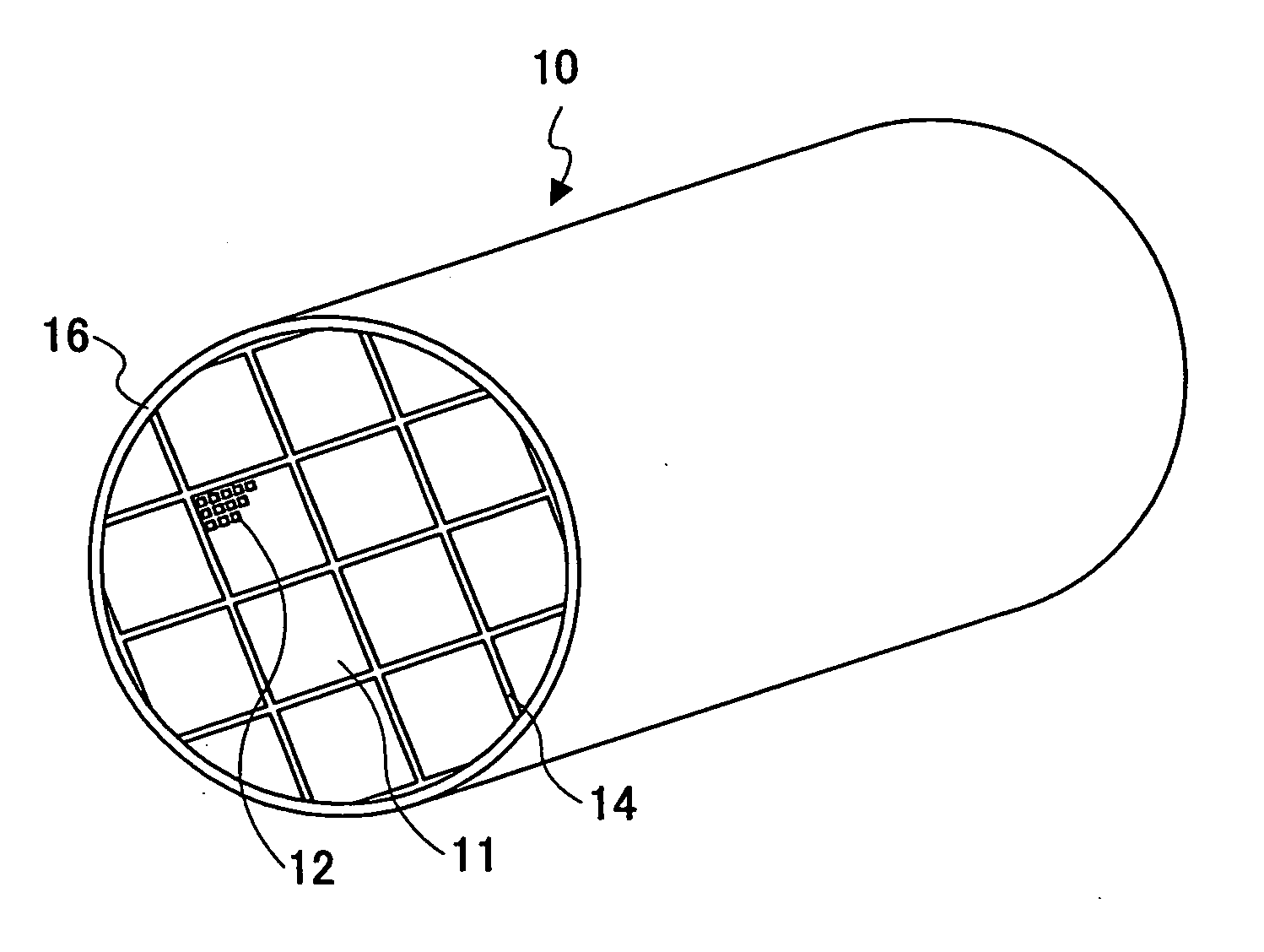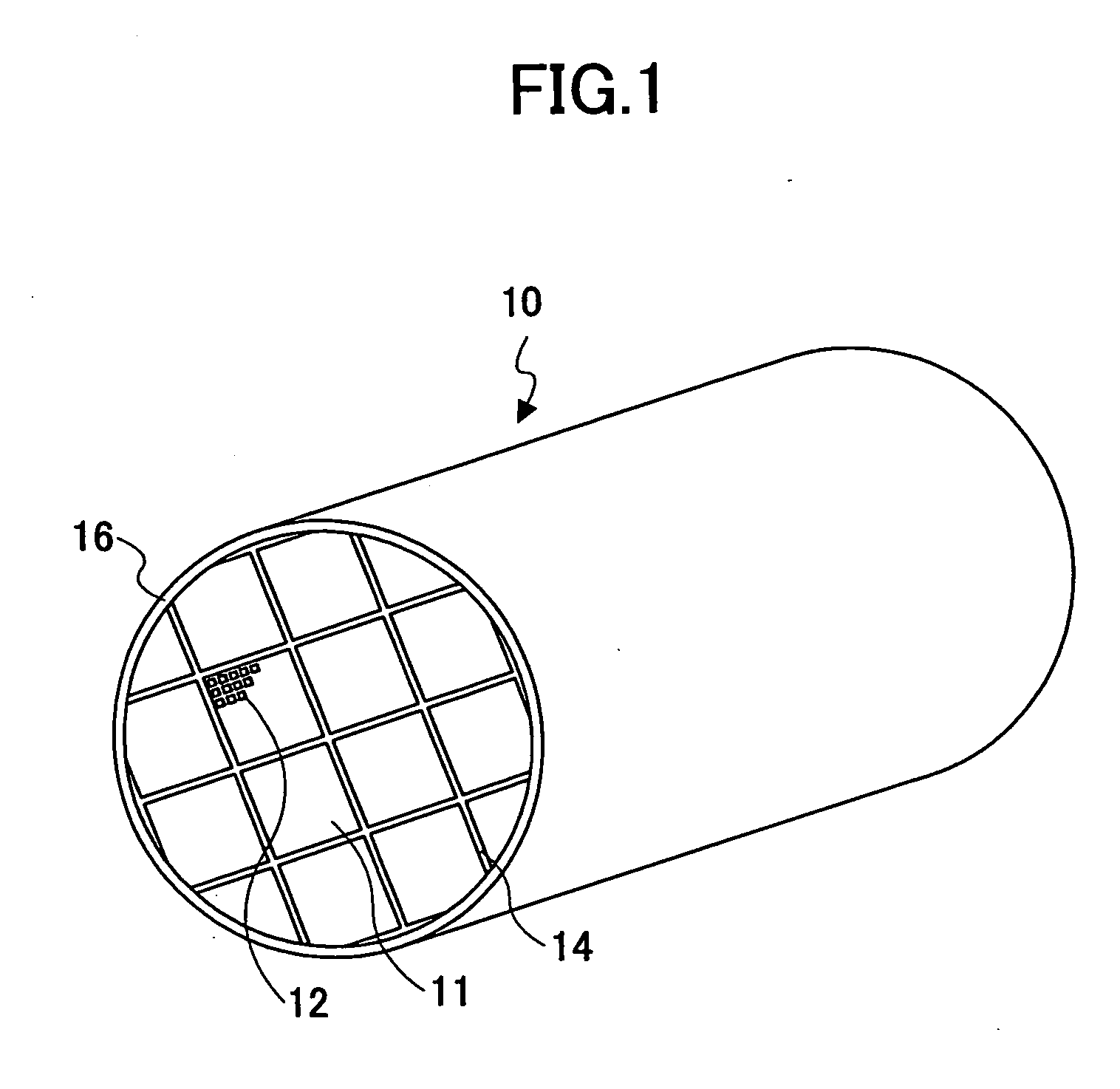Honeycomb structure
- Summary
- Abstract
- Description
- Claims
- Application Information
AI Technical Summary
Benefits of technology
Problems solved by technology
Method used
Image
Examples
example 1
[0058] First, 40 wt % of γ-alumina particles (2 μm in average particle size), 10 wt % of silica-alumina fibers (10 μm in average fiber diameter, 100 μm in average fiber length, and of an aspect ratio of 10), and 50 wt % of silica sol (of a solid concentration of 30 wt %) were mixed. Six parts by weight of methylcellulose as an organic binder was added, together with small amounts of a plasticizer and lubricant, to 100 parts by weight of the obtained mixture. The mixture was further mixed and kneaded, so that a mixture composition was obtained. Next, the mixture composition was subjected to extrusion molding by an extruder, so that crude molded bodies were obtained.
[0059] The crude molded bodies were sufficiently dried using a microwave drier and a hot air drier, and were degreased, being heated at 400° C. for 2 hours. Thereafter, the molded bodies were subjected to firing, being heated at 800° C. for 2 hours. As a result, the honeycomb units 11 each having a prism-like shape (34.3 ...
examples 2 through 7
[0064] The honeycomb structures 10 were made in the same manner as in Example 1 except that the honeycomb units 11 were made into respective shapes shown in Table 1. The shapes of the joint bodies of Examples 2, 3, and 4 are shown in FIGS. 5B, 5C, and 5D, respectively, and the shapes of the joint bodies of Examples 5, 6, and 7 are shown in FIGS. 6A, 6B, and 6C, respectively. In Example 7, the honeycomb structure 10 was monolithically formed, and accordingly, the joining process and the cutting process were not performed.
examples 8 through 14
[0065] The honeycomb units 11 were made in the same manner as in Example 1 except that the honeycomb units 11 were made into respective shapes shown in Table 1 using titania particles (2 μm in average particle size) instead of ceramic particles. Then, the honeycomb structures 10 were made in the same manner as in Example 1 except that the ceramic particles of the seal material layer 14 and the coating material layer16 were replaced with titania particles (2 μm in average particle size). The joint bodies of Examples 8 through 11 are equal in shape to those of FIGS. 5A through 5D, respectively. The joint bodies of Examples 12 through 14 are equal in shape to those of FIGS. 6A through 6C, respectively. In Example 14, the honeycomb unit 10 was monolithically formed.
PUM
| Property | Measurement | Unit |
|---|---|---|
| Length | aaaaa | aaaaa |
| Length | aaaaa | aaaaa |
| Fraction | aaaaa | aaaaa |
Abstract
Description
Claims
Application Information
 Login to View More
Login to View More - R&D
- Intellectual Property
- Life Sciences
- Materials
- Tech Scout
- Unparalleled Data Quality
- Higher Quality Content
- 60% Fewer Hallucinations
Browse by: Latest US Patents, China's latest patents, Technical Efficacy Thesaurus, Application Domain, Technology Topic, Popular Technical Reports.
© 2025 PatSnap. All rights reserved.Legal|Privacy policy|Modern Slavery Act Transparency Statement|Sitemap|About US| Contact US: help@patsnap.com



